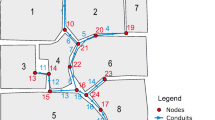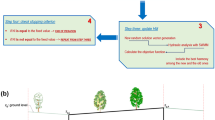Abstract
Urban encroachment in natural floodplain areas and infrastructures interfering with watercourses have caused higher flood risks in lowland areas. In this context, detention basins have become a fundamental instrument for stormwater and environmental management at watershed scale. Numerical methods of flood routing are generally coupled with optimization algorithms to investigate the factors that affect the overall efficiency of detention basins in controlling the peak flows throughout a watershed. To overcome the procedure effort due to numerical integration, a simple innovative approach, based on the linear system theory applied to the solution of hydrologic flood routing, is proposed for a preliminary estimate of overall efficiency. First a numerical analysis is performed to ensure that the schematization of the detention basin as a linear system leads to technically acceptable approximation. Then, a simple analytical equation is provided that allows a preliminary estimate of detention basin efficiency in downstream river reaches. Sensitivity analysis of the above equation provides information about the factors that most contribute to the downstream flow reduction variability. Finally, the proposed methodology, adequately extended to a parallel system of stormwater detention basins within a watershed, can be easily integrated in optimization algorithms.




Similar content being viewed by others
References
ASCE (1917) Final report of the special committee on floods and flood prevention. Trans ASCE Paper no.1400 81(1):1218–1234
Basha HA (1994) Nonlinear reservoir routing: particular analytical solution. J Hydraul Eng-ASCE 120(5):624–632
Basha HA (1995) Routing equations for detention reservoirs. J Hydraul Eng-ASCE 121(12):885–888
Bedient BP, Huber WC, Vieux BE (2012) Hydrology and floodplain analysis. Wiley, New York
Behera PK, Papa F, Adams BJ (1999) Optimization of regional storm-water management systems. J Water Resour Plann-ASCE 125(2):107–114
Bennett MS, Mays LW (1985) Optimal design of detention and drainage channel systems. J Water Resour Plann-ASCE 111(1):99–112
Bernard MM (1932) Formulas for rainfall intensities of long duration. Trans ASCE Paper No.1801 96(1):592–624
Brun R, Reichert P, Künsch HR (2001) Practical identifiability analysis of large environmental simulation models. Water Resour Res 37(4):1015–1030
Camnasio E, Becciu G (2011) Evaluation of the feasibility of irrigation storage in a flood detention pond in an agricultural catchment in Northern Italy. Water Resour Manag 25(5):1489–1508
Campolongo F, Saltelli A (1997) Sensitivity analysis of an environmental model: an application of different analysis methods. Reliab Eng Syst Safe 57:49–69
Chen CN, Tsai CH, Tsai CT (2007) Reduction of discharge hydrograph and flood stage resulted from upstream detention ponds. Hydrol Process 21(25):3492–3506
Chow VT, Maidment DR, Mays LW (1988) Applied hydrology. Mc Graw-Hill Book Company, New York
Di Natale M, Golia UM, Greco R (1999) Sul dimensionamento di massima di un sistema di vasche di laminazione per il controllo delle piene in una rete di drenaggio. La difesa idraulica del territorio, Universitá di Trieste (in italian)
Emerson CH, Welty C, Traver RG (2005) Watershed scale evaluation of a system of stormwater detention basins. J Hydraul Eng-ASCE 10(3):237–242
Fu G, Khu ST, Butler D (2010) Optimal distribution and control of storage tank to mitigate the impact of new developments on receiving water quality. J Environ Eng-ASCE 136(3):335–342
Giua A, Seatzu C (2009) Analisi dei sistemi dinamici. Springer, Berlin
Goff KM, Gentry RW (2006) The influence of watershed and development characteristics on the cumulative impacts of stormwater detention ponds. Water Resour Manag 20(6):829–860
Graber SD (2009) Generalized numerical solution for detention basin design. J Irrig Drain Eng-ASCE 135(4):487–492
Guo Y, Adams BJ (1999) An analytical probabilistic approach to sizing flood control detention facilities. Water Resour Res 35(8):2457–2468
Hager WH, Sinniger R (1985) Flood storage in reservoirs. J Irrig Drain Eng-ASCE 111(1):76–85
Hall MJ, Hockin DL, Ellis JB (1993) Design of flood storage reservoirs. CURIA and Butterworth-Heinemann, London
Hamby DM (1994) A review of techniques for parameter sensitivity analysis of environmental models. Environ Monit Assess 32:135–154
Hong YM (2008) Graphical estimation of detention pond volume for rainfall of short duration. J Hydro-Environ Res 2(2):109–117
James WP, Bell JF, Leslie DL (1987) Size and location of detention storage. J Water Resour Plann-ASCE 113(1):15–28
Kessler A, Diskin MH (1991) The efficiency function of detention reservoirs in urban drainage systems. Water Resour Res 27(3):253–258
Koutsoyiannis D, Kozonis D, Manetas A (1998) A mathematical framework for studying rainfall intensity-duration-frequency relationships. J Hydrol 206(1–2):118–135
Linsley RK, Kohler MA, Paulhus JLH (1982) Hydrology for engineers. McGraw-Hill, New York
Luenberger DG (1979) Introduction to dynamic systems: theory, models and applications. Wiley, New York
Maidment DR (1993) Developing a spatially distributed unit hydrograph by using GIS. HydroGIS 93: IAHS-AISH P. In: Proc. Vienna Conference, IAHS Publ. 211, pp 181–192
Marzolo F (1933) I serbatoi di piena. L’energia elettrica, pp 269–284 (in italian)
Mays LW, Bedient PB (1982) Model for optimal size and location of detention. J Water Resour Plann-ASCE 108(3):270–284
McCuen RH (1974) A regional approach to urban storm water detention. Geophys Res Lett 1(7):321–322
McCuen RH (1979) Downstream effects of stormwater management basins. J Hydraul Eng Div-ASCE 118(11):1343–1356
McEnroe BM (1992) Preliminary sizing of detention reservoirs to reduce peak discharges. J Hydraul Eng-ASCE 118(11):1540–1549
Miotto F, Laio F, Claps P (2006) Metodologie speditive per la valutazione dell’effetto di laminazione dei grandi invasi. XXX Convegno di Idraulica e Costruzioni Idrauliche IDRA, Politecnico di Torino (in italian)
Moisello U (1999) Idrologia tecnica. La Goliardica Pavese, Pavia
Paik K (2008) Analytical derivation of reservoir routing and hydrological risk evaluation of detention basins. J Hydrol 352:191–201
Ponce VM (1989) Engineering hydrology, principle and practice, 1st edn. Prentice Hall, New York
Simon A (1981) Basic hydraulics. Wiley, New York
Singh VP (1996) Kinematics wave modeling: water resources engineering, 1st edn. Wiley, New York
Smith AA, Lee KB (1984) The rational method revisited. Can J Civil Eng 11(4):854–862
Tsihrintzis VA, John DL, Tremblay PJ (1998) Hydrodynamic modeling of wetlands for flood detention. Water Resour Manag 12(4):251–269
Yeh CH, Labadie JW (1997) Multiobjective watershed-level planning of storm-water detention basins. J Water Resour Plann-ASCE 123(6):336–343
Author information
Authors and Affiliations
Corresponding author
Appendix
Appendix
Solution of Eq. 17 is a piecewise function on intervals \([0, \overline {t}_{li} + \overline {t}_{ci}]\), \([\overline {t}_{li} + \overline {t}_{ci}, \infty ]\) which correspond, in order, the following solutions
Solution of convolution integral of Eq. 18 is a piecewise function on intervals \([0, \overline {t}_{li}], [\overline {t}_{li}, \overline {t}_{ci}+\overline {t}_{li}], [\overline {t}_{ci}+\overline {t}_{li}, \overline {t}_{r}+\overline {t}_{li}], [\overline {t}_{r}+\overline {t}_{li}, \overline {t}_{r}+\overline {t}_{ci}+\overline {t}_{li}], [\overline {t}_{r}+\overline {t}_{ci}+\overline {t}_{li}, \infty ]\) because the response function (17), the inflow hydrograph Q i (t) to detention basin and the outflow hydrograph Q o (t) are discontinuous (Fig. 5a). Thus, the outlet dimensionless hydrograph difference at WS f outlet point f are listed in the following, according to the specified interval order
Solution of convolution integral Eq. 20 is a piecewise function on intervals \([0, \overline {t}_{li}], [\overline {t}_{li}, \overline {t}_{ci}+\overline {t}_{li}], [\overline {t}_{ci}+\overline {t}_{li}, 1], [1, \overline {t}_{r}], [\overline {t}_{p}, \overline {t}_{r}+\overline {t}_{li}], [\overline {t}_{r}+\overline {t}_{li}, \overline {t}_{r}+\overline {t}_{ci}+\overline {t}_{li}], [\overline {t}_{r}+\overline {t}_{ci}+\overline {t}_{li}, 1+\overline {t}_{r}], [1+\overline {t}_{r}, \infty ]\) (Fig. 5b).
The different solutions are listed in the following, according to the specified interval order
Rights and permissions
About this article
Cite this article
Del Giudice, G., Gargano, R., Rasulo, G. et al. Preliminary Estimate of Detention Basin Efficiency at Watershed Scale. Water Resour Manage 28, 897–913 (2014). https://doi.org/10.1007/s11269-014-0518-1
Received:
Accepted:
Published:
Issue Date:
DOI: https://doi.org/10.1007/s11269-014-0518-1





